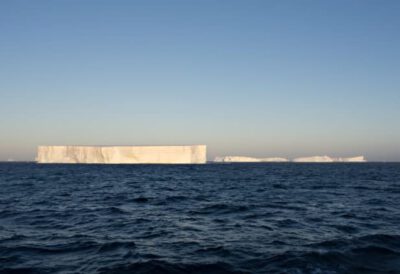
The melting of the supergiant iceberg A-68 had a huge impact on the ocean around South Georgia, in sub-Antarctica, and significantly changed the Southern Ocean's temperature and saltiness, with potentially major consequences for this ecologically significant region. The results are published this week in the journal Geophysical Research Letters.
In 2020, A-68 – a supergiant iceberg about the size of Luxembourg that calved from the Larsen C ice shelf in 2017 – drifted very close to South Georgia before starting to break up, releasing huge quantities of fresh, cold meltwater in a relatively small region
Researchers from British Antarctic Survey and University of Sheffield used satellite data to observe how the melting iceberg affected the temperature and saltiness, or salinity, of the top few centimetres of the ocean surface.
They observed the meltwater caused extreme anomalies in the temperature and saltiness of the waters at the ocean surface, of magnitudes that have not been reported for any previous iceberg disintegration so far. Researchers recorded temperatures up to 4.5°C colder than average. The salinity was reduced by more than 10 psu (a way of measuring the amount of salt in water) meaning the surface ocean became around two-thirds of its normal saltiness.
This ‘signal' from the melted iceberg eventually extended well beyond South Georgia; it was carried by ocean currents to form a long plume that stretched up to more than 1000km across the South Atlantic – roughly the distance from Land's End to John O'Groats.
The meltwater signal also took a long time to disappear – it was still visible more than two months after the iceberg disintegrated.
These changes to the physical conditions at the ocean surface have important links to the biological conditions. For example, meltwater contains dissolved iron which stimulates the growth of microscopic plants called phytoplankton that form the base of the ocean's food web.
However, this meltwater can also have negative impacts, altering the temperature, salinity and nutrient conditions that many of the Southern Ocean's inhabitants are adapted to thrive in.
The calving of this massive iceberg created a unique opportunity to assess the impact melting on surface ocean conditions.
Climate scientist Roseanne Smith at British Antarctic Survey and co-author of the study said: “The A-68 iceberg was one of the largest and most studied of all icebergs. When it started to break apart, it was a bit like installing a major river estuary into the open ocean, pumping cold, freshwater into the surface layer.
Our results show that each individual melting giant iceberg can have widespread and long-lasting impacts on the conditions at the surface of the Southern Ocean, and this has consequences for the plant and animal life that lives there.”
read more www.bas.ac.uk/media-post/supergiant-iceberg-makes-surrounding-ocean-surface-colder-and-less-salty/








